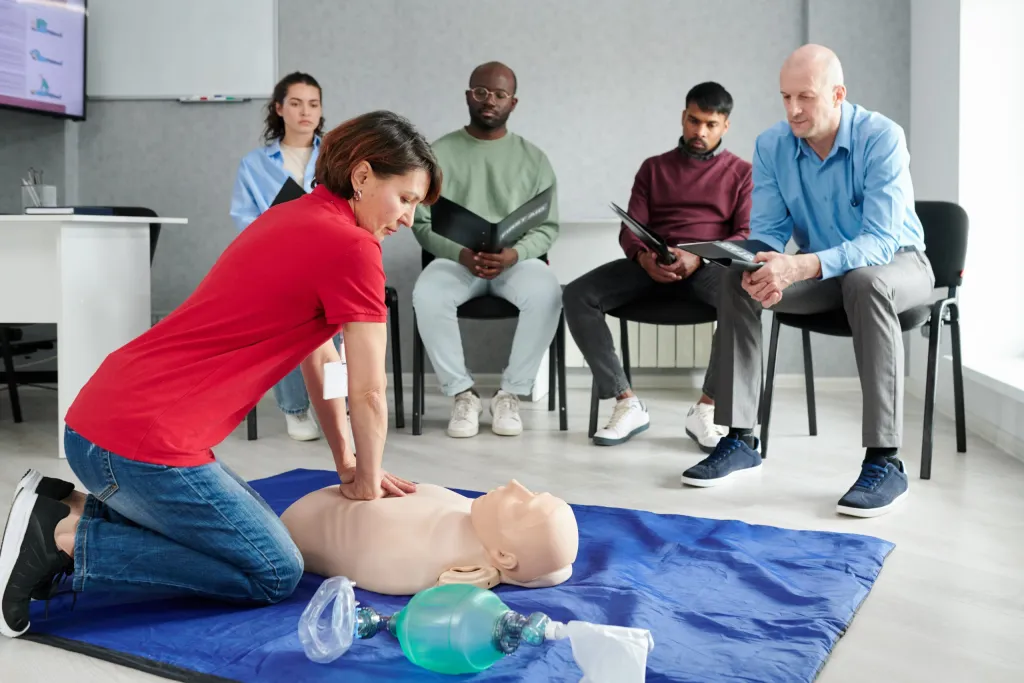Cardiac emergencies are increasing widely. In America alone, there are more than 350,000 out-of-hospital cardiac incidents per year. Realistically, over 90 percent of those afflicted are dying. The largest percentage of these emergencies happen at home, and over 15 percent happen in an open place. According to the statistics, early CPR can increase the survival rate of a person by two to three times. Nevertheless, the proportion of those bystanders who will intervene is about ten percent, and it tends to be because of fear or a lack of training. That distance might spell the difference between life and death.
A half online, half in-person blended course is a flexible and efficient solution to develop not only knowledge but physical abilities as well. The participants will be able to complete the theoretical parts at their convenience and then visit a practical session and model the coursework.
Understanding What CPR Really Does?
Cardiopulmonary Resuscitation, often abbreviated as CPR, is the essential emergency procedure to be applied when the heart of a person ceases to beat. It sustains the blood circulation to the brain and other vital organs until medical assistance is found. The aim is straightforward, which is to maintain the flow of oxygenated blood throughout the body.
CPR continues to rely on chest compressions. They mimic the pumping effect of the heart, forcing the blood where it is needed most. Rescue breathing may also be required to supply oxygen in certain situations, especially in children or older children. Even a hands-only CPR performed without mouth-to-mouth breaths can help to save lives if it is executed instantly and appropriately.
Know the Signs of Cardiac Arrest
Among the most significant problems is the need to learn when CPR is really required. Cardiac arrest gets confused with a heart attack, but they are different. In case of these signs, do not hesitate. Dial emergency services and start CPR. That is what to notice during sudden cardiac arrest:
- This individual falls down and becomes unresponsive.
- The respiration ceases or becomes laboured (gasp).
- The individual is unresponsive to noise and physical stimuli.
- You cannot detect a pulse, or the pulse is extremely weak.
Types of CPR and When to Use Them
Performing CPR in those first critical minutes keeps blood flowing. This buys time until professionals can take over, dramatically improving the person’s chances of survival and recovery. There are two primary forms of CPR that people learn:
- Compression-Only CPR
This method involves pressing hard and fast in the center of the chest at a rate of 100–120 compressions per minute. It’s simple, doesn’t require mouth-to-mouth contact, and is effective in most adult emergencies.
- CPR with Rescue Breaths
This method combines compressions with breaths. It’s crucial for children, infants, and situations involving drowning or drug overdose. It requires proper training but delivers oxygen directly to the lungs in addition to circulating blood. Both techniques serve the same purpose: to keep the brain and organs alive until medical help arrives.
The Value of Formal CPR Training
Learning CPR is also vital in emergencies like choking, near-drowning, or drug overdose, where oxygen flow is compromised. In such scenarios, applying CPR techniques immediately can stabilize the person and prevent brain damage.
Watching a video is helpful, but it’s not enough. Real learning comes from hands-on practice. For example, CPR certification near Ottawa equips individuals with skills and techniques to revive a person after a cardiac arrest. It helps them feel confident and capable during emergencies. Such training and certification courses typically include:
- Hands-on chest compression and rescue breath practice
- AED (Automated External Defibrillator) use
- Simulated emergency scenarios
It Matters in Public and Personal Settings
Emergencies may occur in concerts, sports events, schools, or even in your living room. A majority of individuals who have ever been trained on using CPR do not expect to do so themselves. When they do, it is generally with someone familiar to them: a relative, a friend, or a colleague.
In case of cardiac arrest, very little time remains. When oxygen no longer reaches the brain, brain damage may commence after only four minutes. The damage may be permanent in eight minutes. Sadly, though, response sometimes takes longer, especially in rural or other densely populated parts of a city. Bystanders are at the first line of defense in that gap.
Sudden cardiac arrest also tops the mortality cases in school campuses. As 20 percent of the population goes to school each day, it becomes a matter of public trust to know CPR. Through CPR training, anybody can be a hero.
Take the First Step Toward Saving a Life
People are reluctant to undergo training because they think it is either too hard or unnecessary. CPR Certification is simple to obtain, and even incomplete CPR is still preferable to no CPR at all.
Each society should have more learned and ready-to-act individuals. The more CPR-trained bystanders there are, the higher the community survival rate. It is as easy as that. Training not only makes a person ready to assist others, but also gives them abilities that might one day be utilized to save a loved one.
Conclusion
It may be in the heat of a crowd or in the calm of your living room, knowing how to perform CPR equips you to step up when seconds matter most. CPR transforms bystanders into first responders, closing the gap between collapse and professional care. Anyone interested in getting practical training can get a CPR Certification, so you can be prepared when you need it the most.



